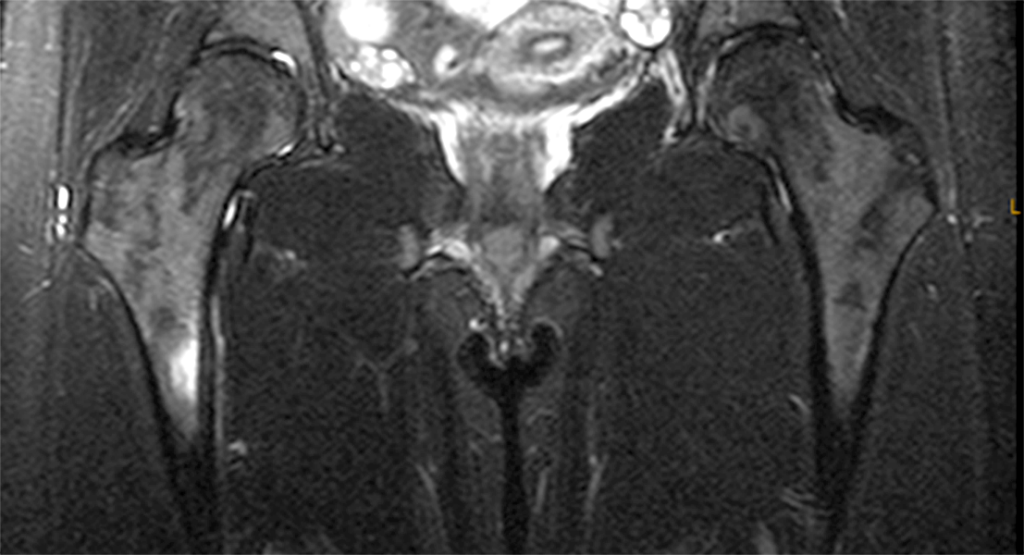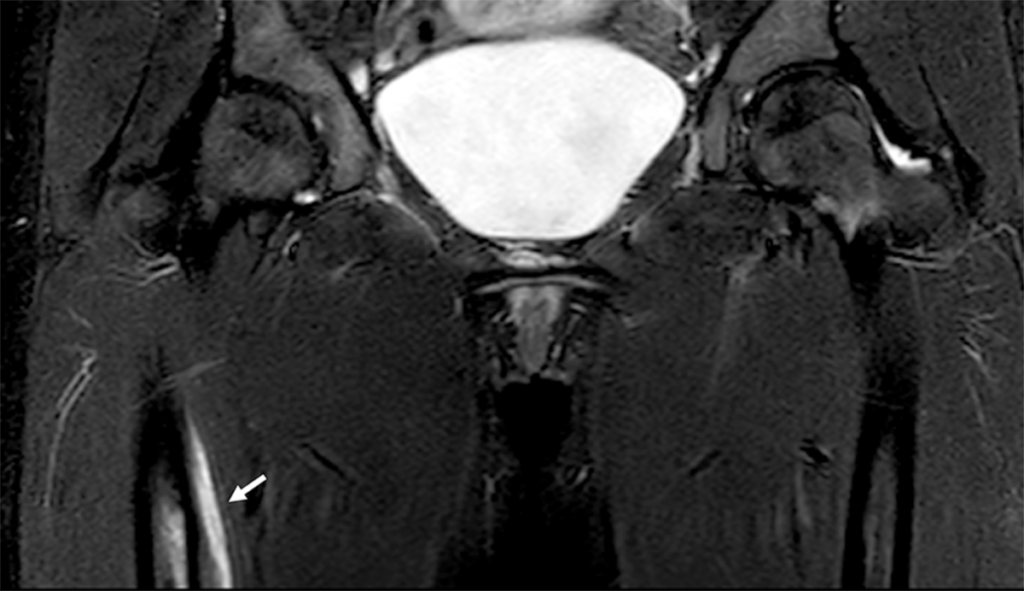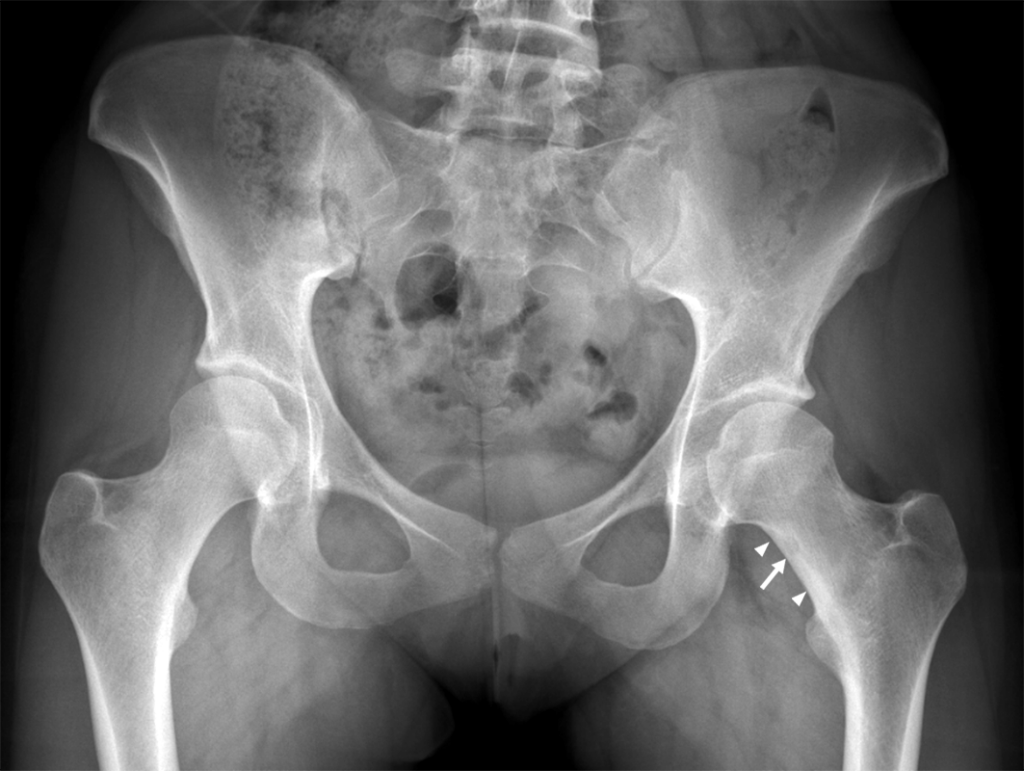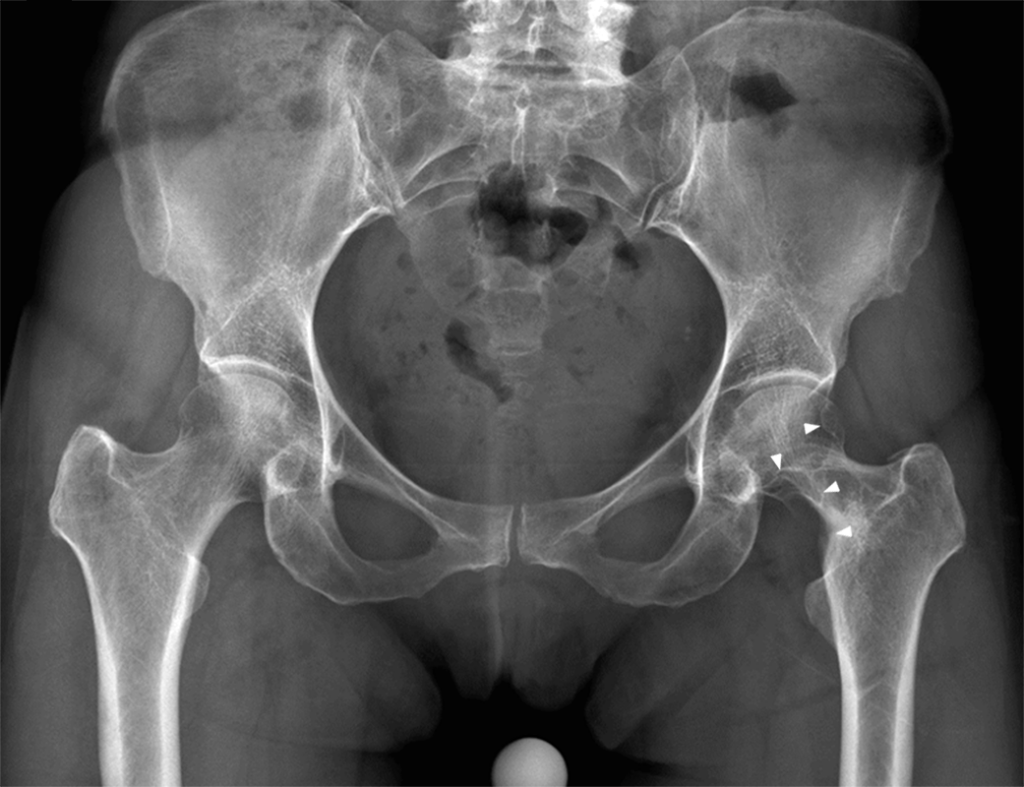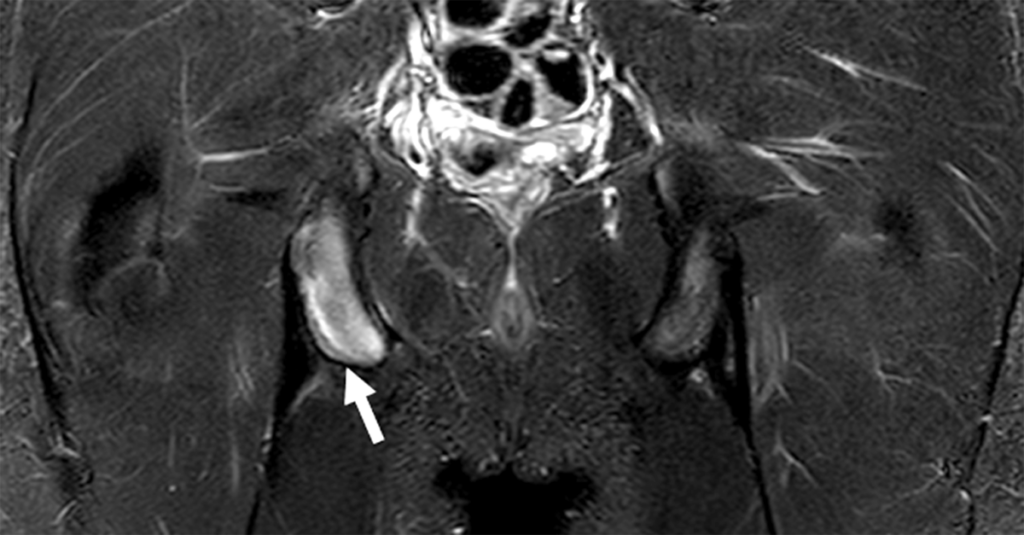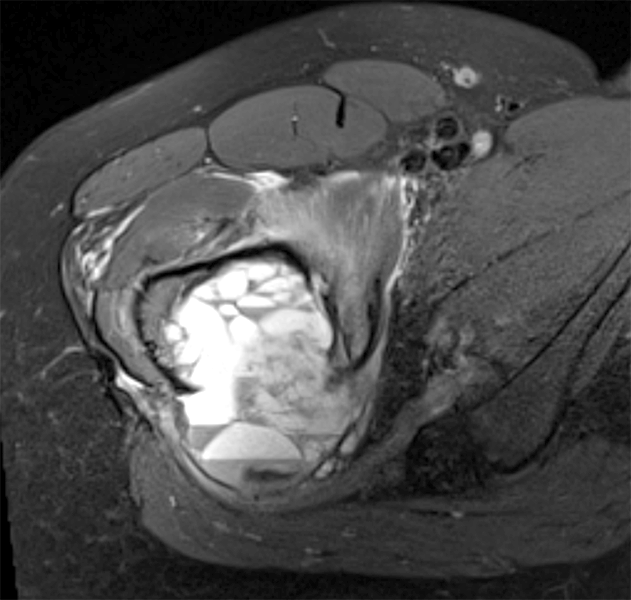Clinical History: 18-year-old track athlete with left thigh pain. Fat-suppressed T2-weighted axial (1a) and STIR coronal (1b) images are provided. What are the findings? What is your diagnosis?
Findings
Diagnosis
Adductor Insertion Avulsion Syndrome (Thigh Splints)
Introduction
Hip and thigh pain is a common complaint among athletes with a hip injury rate of 53.1 per 100,000 athletic exposures in National Collegiate Athletic Association athletes.1,2 The etiologies include intra-articular or extra-articular pathologies arising in the bones or soft tissues of the hip, thigh, or groin.3,4
Adductor insertion avulsion syndrome, or “thigh splints”, is a painful traction-related stress injury of the proximal to mid femur at the adductor insertions along the posteromedial femoral diaphysis (3). It is an important and sometimes overlooked cause of hip pain1, 5 and has been described in adults6,7and children.7,8
This web clinic reviews adductor insertion avulsion syndrome (thigh splints), and the differential diagnosis for hip/thigh pain in the athlete.
Clinical Presentation
Thigh splints typically present with activity-related groin or posteromedial proximal thigh pain relieved with rest.4
Physical examination findings include increased adductor tone, tenderness over the adductor muscles and severe pain with active resistance to hip adduction and external rotation.3
Imaging
MRI findings include a thin rim of hyperintense water-sensitive sequence signal (T2 and STIR) along the medial cortex of the proximal to mid femoral shaft consistent with periostitis.3 Mild adjacent soft tissue edema may also be present. In advanced cases, cortical and bone marrow edema may be present consistent with developing stress fracture (4a, 4b, 4c).
Figure 4:
Female runner with right hip and thigh pain. Fat-suppressed T2-weighted large field of view coronal (4a) and fat-suppressed T2-weighted small field of view coronal (4b) and axial (4c) images demonstrate moderate medial proximal right femoral shaft periosteal and endosteal edema (solid arrows) and a coronally oriented medial cortical fracture line (dashed arrow).
Given the insertion sites of the adductor muscles, thigh splints are commonly at the inferior edge of the field of view for a typical hip or pelvis MRI (5a and 5b).
Figure 5:
20-year-old female cross country runner with right hip and thigh pain. Right hip frog leg lateral radiograph (5a) reveals immature periosteal reaction (arrow) along the posteromedial femoral shaft at the junction of the proximal and middle thirds. The large field of view fat-suppressed T2-weighted coronal image of the pelvis demonstrates periosteal and endosteal marrow edema in the same location of the right femur. The dedicated right hip small field of view images did not include the pathology (not shown).
Initial radiographs may be normal or show fluffy immature periostitis (6a). Over time periostitis will mature and become smooth (6b).
Bone scintigraphy, if performed, demonstrates a linear band of increased radiotracer uptake along the posteromedial femur on delayed images.6
Differential Diagnosis
The differential diagnosis for thigh splints is broad and can be broken down into intra-articular hip pathology and extra-articular hip, thigh, and groin pathology.
Intra-articular etiologies of hip and thigh pain include osseous and soft tissue pathologies. Femoral neck stress fracture (7), osteochondral injuries (8) and either benign (9) or malignant osseous tumors are examples of intraarticular osseous pathologies. Acetabular labrum tear (10) and synovial-based processes (11) are examples of intraarticular soft tissue pathologies.
Figure 9:
24-year-old female with chronic left hip pain. AP radiograph of the pelvis (9a) and bone-windowed coronal CT image (9b) of the left hip demonstrating a cortically based inferior femoral neck lytic lesion (arrows) and mild cortical thickening (arrowheads). The patient was managed with CT guided radiofrequency ablation. Pathology at the time of ablation was consistent with osteoid osteoma.
Figure 11:
56-year-old female with left hip pain. AP radiograph of the pelvis (11a) shows extensive remodeling of the left femoral neck. Fat-suppressed T2-weighted coronal image (11b) of the left hip demonstrates extensive remodeling of the left femoral neck with extensive nodular synovitis (asterisks). Pathology was synovial chondromatosis.
Extraarticular etiologies of hip and thigh pain include osseous and soft tissue pathologies. Apophyseal injury (12), benign (13) or malignant osseous tumor (14) and osteomyelitis are examples of extraarticular osseous pathologies. Athletic pubalgia (15), muscle strain (16), muscle contusion (17) and benign or malignant soft tissue tumors are examples of extraarticular soft tissue pathologies.
Figure 13:
22-year-old female with thigh pain. AP right femur radiograph (13a) with a large cortically based midshaft lytic lesion. Fat-suppressed T2-weighted axial image of the right femur (13b) with a large cortically based lesion containing a fluid-fluid level and mild periostitis (arrow). Biopsy was consistent with osteoblastoma.
Figure 14:
20-year-old female with recently worsening right hip pain. Frog leg lateral radiograph (14a) and fat-suppressed T2-weighted axial image (14b) of the right hip with expansile lytic lesion centered in the femoral neck (arrowheads), pathologic lesser trochanter fracture (arrow) and fluid-fluid levels on MR. At pathology, this was found to be a telangiectatic osteosarcoma.
Treatment
Once a diagnosis of thigh splints has been determined, the athlete should be managed conservatively with rest and gradual return to physical activity.4
Conclusion
Adductor insertion avulsion syndrome, or “thigh splints”, should be considered in the differential diagnosis for an athlete or active individual with groin, hip or proximal medial thigh pain. Given the wide range of both intraarticular and extraarticular pathology resulting in groin, hip or thigh pain, MR imaging is commonly used to make the diagnosis of thigh splints. Due to the location of the injury, close attention to the inferior edge of the field of view for a typical hip or pelvis MRI is often necessary to make the diagnosis.
References
- Bojicic KM, Meyer NB, Yablon CM, Brigido MK, Gaetke-Udager K. Hip Pain: Imaging of intra-articular and extra-articular causes. Clin Sports Med. 2021; 713 (40). ↩
- Cruz CA, Kerbel Y, Smith CM, Prodromo J, Trojan JD, Mulcahey MK. A sport-specific analysis of the epidemiology of hip injuries in National Collegiate Athletic Association athletes from 2009 to 2014. Arthroscopy. 2019; 2724 (35). ↩
- Anderson MW, Kaplan PA, Dussault RG. Adductor insertion avulsion syndrome (thigh splints): Spectum of MR imaging features. AJR. 2001; 673 (177). ↩
- Hegazi TM, Belair JA, McCarthy EF, Roedl JB, Morrison WB. Sports injuries about the hip: what the radiologist should know. Radiographics. 2016; 1717 (36). ↩
- Pauchet A, Falticeanu A, Lebecque O. Adductor insertion avulsion syndrome with proximal femoral shaft stress fracture: not only found in young athletes. J of the Belgian Society of Radiology. 2020; 1 (104). ↩
- Charkes ND, Siddhivam N, Schneck CD. Bone scanning in the adductor insertion avulsion syndrome. J Nucl Med. 1987; 1835 (28). ↩
- Tshering-Vogel D, Waldherr C, Schindera ST, Steinbach LS, Stauffer E, Anderson SE. Adductor insertion avulsion syndrome, “thigh splints”: relevance of radiological follow-up. Skeletal Radiol. 2005; 355 (34). ↩
- Anderson SE, Johnston JO, O’Donnell R, Steinbach LS. MR imaging of sports-related pseudotumor in children: mid femoral diaphyseal periostitis at insertion site of adductor musculature. AJR. 2001; 1227 (176). ↩






